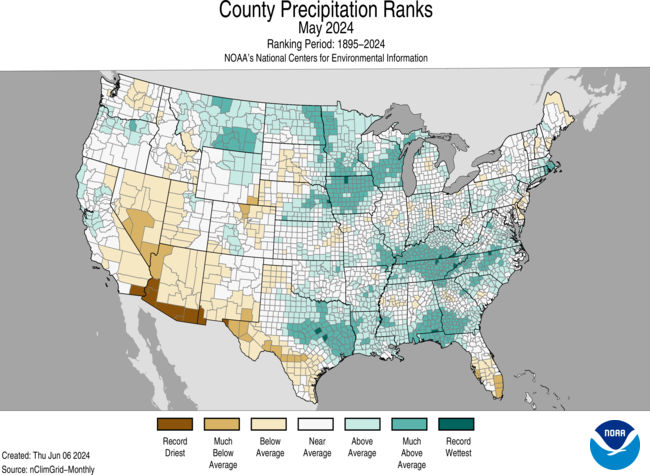Weather Extremes and Variability in Corn Yield
November 13, 2024
Extreme wet weather during the 2024 spring planting season (Figure 1) coupled with extreme dry weather during grain fill (Figure 2) created a combination of factors that have impacted yields in the region of southern Minnesota and northern Iowa. These factors ranged from forcing growers to plant in wet conditions—which in turn encouraged soilborne diseases that are more common in wet soils—to reductions in root growth resulting in shallow rooting depth, to loss of nitrogen (N) at a critical time during vegetative growth.


Impacts of a Wet Spring on Planting
The wet spring resulted in delaying planting past the optimum window for maximum yield potential in many areas within this region. Planting that did occur during wet soil conditions resulted in planting failures, such seed furrows that did not collapse or close, which then resulted in side-wall compaction and root restriction later in the growing season. For seed that was already planted, cool and wet conditions delayed emergence and allowed for an increase in the infection potential for seeds and seedlings soilborne diseases.
Impacts of a Wet Spring on Seedlings
Pythium, Fusarium, and Rhizoctonia are soilborne diseases that attack seedlings in wet and cool conditions. Pythium is especially common in wet soils and infection can result in loss of stand.1 Fusarium species can cause crown rot, and a recent study in South Dakota found at least eight species of Fusarium causing crown rots in that state.2 Rhizoctonia can also cause crown rot and brace root rot.1 In some cases, infections that occur at the seedling stage may not manifest until later in the season, when plants stressed by excessive moisture or dry conditions develop stalk rot or crown rot.
For seedlings that developed in the extreme weather conditions in 2024, cold and saturated soils reduced their available oxygen, inhibiting root growth, leaf growth, and photosynthesis. Generally, in these growing conditions leaves and sheaths may turn purple from the accumulation of sugars if photosynthesis continues but growth is slowed. Root growth can compensate to some extent later in the season. However, a saturated profile early in the season can limit root growth to the top several inches of soil and encourage late-season root rots and lodging.
Impacts of a Dry Late Summer
The rollercoaster of water availability across the 2024 growing season in southern Minnesota is demonstrated in Figure 3. Saturated soils, like those seen in 2024, can also result in denitrification (loss of N to the atmosphere, mainly as nitrous oxide gas) or leaching (movement of N beyond the rooting zone). Lost nitrogen can then result in late-season N deficiencies, which may contribute to higher levels of stalk rots.
For eastern Iowa, the departure from normal precipitation during grain fill is illustrated in Figure 4. The record dry conditions during grain fill negatively impacted kernel size and number. Furthermore, the shallow root depth combined with the extreme dry conditions to impact plants’ ability to develop their number of kernels to their genetic potential.


Together, these extreme weather factors throughout the growing season combined to impact yields across Minnesota and Iowa.
Sources
1Robertson, A., Wise, K., and Jackson-Ziems, T. 2023. Frequently asked questions about crown rot in corn. Crop Protection Network. https://cropprotectionnetwork.org/publications/frequently-asked-questions-about-crown-rot-in-corn
2Okello, P.N., Petrović, K., Kontz, B., and Mathew, F.M. 2019. Eight species of Fusarium cause root rot of corn (Zea mays) in South Dakota. Plant Health Progress. 20(1):38–43. https://doi.org/10.1094/PHP-11-18-0075-RS
Web sources verified 11/6/24. 1122_467701